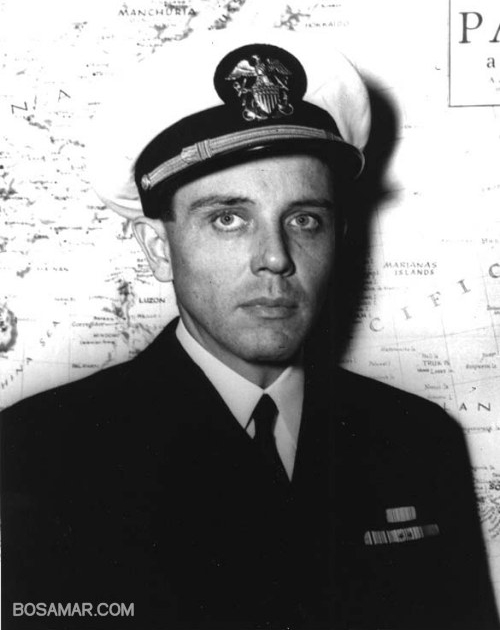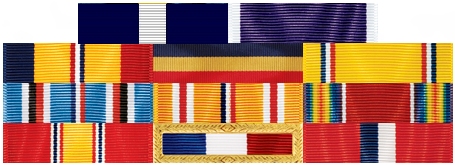Commanding Officer
USS SAMUEL B. ROBERTS (DE 413)

U.S. Navy photograph
Lieutenant Commander Robert Witcher Copeland, U.S. Navy

| Navy Cross | |
| Purple Heart | |
| Combat Action Ribbon | |
| Presidential Unit Citation | |
| American Defense Service Medal | |
| American Campaign Medal | |
| Asiatic-Pacific Campaign Medal | |
| World War II Victory Medal | |
| National Defense Service Medal | |
| Philippine Presidential Unit Citation | |
| Philippine Liberation Medal | |
| Award Criteria | |
| RANK | DATES | DUTY STATION/EVENT |
| - | 1910 | Born in Tacoma, Washington |
| - | 1929 - 1935 | University of Washington |
| ENS | 1935 -1940 | Naval Reserve Forces Command |
| ENS | 1940 | USS PAWTUCKET (YT-7) |
| LTJG | 1941 - 1942 | USS BLACK DOUGLAS (PYc-45) |
| LT | 1943 | USS WYMAN (DE-38) |
| LCDR | 1944 | USS SAMUEL B. ROBERTS (DE-413) |
| LCDR | 1945 | Naval War College |
| LCDR | 1945 - 1946 | 5th Naval District |
| CDR | 1947 - ???? | Naval Reserve Forces Command |
| CAPT | ???? - 1960 | Naval Reserve Forces Command |
| RADM | 1961 | Promoted to Rear Admiral |
| RADM | 1961 - 1965 | Naval Reserve Forces Command |
| RADM | 1965 | Retired from Service |
| - | 1973 | Died at Tacoma, Washington |
Short biography of
Rear Admiral Robert Witcher Copeland, U.S. Navy
Robert Witcher Copeland was born in Tacoma, Washington on September 9, 1910. He enlisted in the Naval Reserve in 1929 and was commissioned as a Naval Reserve officer in 1935. Copeland practiced law from 1935 until 1940, when he was ordered to active duty during the Navy's pre-World War II expansion effort.
During the War, he commanded the coal burning tug PAWTUCKET (YT 7), the Costal Patrol Yacht BLACK DOUGLAS (PYc 45), and the destroyer escort WYMAN (DE 38) before taking command of SAMUEL B. ROBERTS (DE 413).
In March 1944 he reported to Houston, Texas where ROBERTS was under construction at the Brown Shipbuilding Company and commissioned on 28 April. Following shakedown off Bermuda from 21 May to 19 June and availability at Boston Navy Yard, ROBERTS departed from Norfolk on 22 July 1944, and transited the Panama Canal to join the Pacific Fleet. She arrived at Pearl Harbor on 10 August and conducted training exercises until sailing on the 21st escorting a convoy to Eniwetok which she reached on 30 August.
On 2 September, she steamed back for Pearl Harbor, arriving there with a convoy on the 10th. Following further training, she got underway on the 21st escorting a convoy to Eniwetok where she arrived on 30 September. ROBERTS proceeded to Manus Island where she joined Task Unit 77.4.3, then steamed for the Leyte Gulf area and commenced operations with the Northern Air Support Group off Samar.
Shortly after dawn on 25 October 1944, Copeland was protecting the escort carriers of Taffy III when a Japanese task force suddenly appeared on the horizon and opened fire. After joining in a daring torpedo attack on the Japanese cruisers and scoring a torpedo hit on one and at least 40 gunfire hits on a second, ROBERTS was hit by a salvo of 14-inch shells which tore a hole 40 feet long and 10 feet wide in the port side of her number 2 engine room. The ship was abandoned and soon sank. Copeland and 119 survivors clung to 3 life rafts for 50 hours before being rescued. Though his ship was lost, this action helped defeat the Japanese counter-offensive against the Leyte invasion. For this, Copeland was awarded the Navy Cross.
Following World War II, Copeland resumed his law career while remaining a member of the Naval Reserve, in which he rose to the rank of Rear Admiral. Robert W. Copeland died at Tacoma, Washington, on August 25, 1973. USS COPELAND (FFG-25) was named in honor of Rear Admiral Robert W. Copeland.
Source: Robert Jon Cox independent research, Samuel B. Roberts Survivors Association and Dictionary of American Naval Fighting Ships
